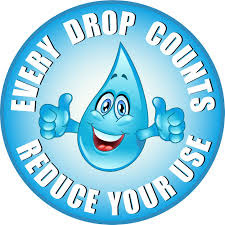
Water conservation in the home...
1. Check faucets and pipes for leaks
A small drip from a worn faucet washer can waste 20 gallons of water per day. Larger leaks can waste hundreds of gallons.
2. Don't use the toilet as an ashtray or wastebasket
Every time you flush a cigarette butt, facial tissue or other small bit of trash, five to seven gallons of water is wasted.
3. Check your toilets for leaks
Put a little food coloring in your toilet tank. If, without flushing, the color begins to appear in the bowl within 30 minutes, you have a leak that should be repaired immediately. Most replacement parts are inexpensive and easy to install.
4. Use your water meter to check for hidden water leaks
Read the house water meter before and after a two-hour period when no water is being used. If the meter does not read exactly the same, there is a leak.
5. Install water-saving shower heads and low-flow faucet aerators
Inexpensive water-saving low-flow shower heads or restrictors are easy for the homeowner to install. Also, long, hot showers can use five to ten gallons every unneeded minute. Limit your showers to the time it takes to soap up, wash down and rinse off. "Low-flow" means it uses less than 2.5 gallons per minute.
You can easily install a ShowerStart showerhead, or add a ShowerStart converter to existing showerheads, which automatically pauses a running shower once it gets warm.
Also, all household faucets should be fit with aerators. This single best home water conservation method is also the cheapest!
6. Put plastic bottles or float booster in your toilet tank
To cut down on water waste, put an inch or two of sand or pebbles inside each of two plastic bottles to weigh them down. Fill the bottles with water, screw the lids on, and put them in your toilet tank, safely away from the operating mechanisms. Or, buy an inexpensive tank bank or float booster. This may save ten or more gallons of water per day.
Be sure at least 3 gallons of water remain in the tank so it will flush properly. If there is not enough water to get a proper flush, users will hold the lever down too long or do multiple flushes to get rid of waste. Two flushings at 1.4 gallons is worse than a single 2.0 gallon flush. A better suggestion would be to buy an adjustable toilet flapperthat allow for adjustment of their per flush use. Then the user can adjust the flush rate to the minimum per flush setting that achieves a single good flush each time.
For new installations, consider buying "low flush" toilets, which use 1 to 2 gallons per flush instead of the usual 3 to 5 gallons.
Replacing an 18 liter per flush toilet with an ultra-low volume (ULV) 6 liter flush model represents a 70% savings in water flushed and will cut indoor water use by about 30%.
7. Insulate your water pipes.
It's easy and inexpensive to insulate your water pipes with pre-slit foam pipe insulation. You'll get hot water faster plus avoid wasting water while it heats up.
8. Take shorter showers.
One way to cut down on water use is to turn off the shower after soaping up, then turn it back on to rinse. A four-minute shower uses approximately 20 to 40 gallons of water.
9. Turn off the water after you wet your toothbrush
There is no need to keep the water running while brushing your teeth. Just wet your brush and fill a glass for mouth rinsing.
10. Rinse your razor in the sink
Fill the sink with a few inches of warm water. This will rinse your razor just as well as running water, with far less waste of water.
11. Use your dishwasher and clothes washer for only full loads
Automatic dishwashers and clothes washers should be fully loaded for optimum water conservation. Most makers of dishwashing soap recomend not pre-rinsing dishes which is a big water savings.
With clothes washers, avoid the permanent press cycle, which uses an added 20 liters (5 gallons) for the extra rinse. For partial loads, adjust water levels to match the size of the load. Replace old clothes washers. New Energy Star rated washers use 35 - 50% less water and 50% less energy per load. If you're in the market for a new clothes washer, consider buying a water-saving frontload washer.
12. Minimize use of kitchen sink garbage disposal units
In-sink 'garburators' require lots of water to operate properly, and also add considerably to the volume of solids in a septic tank which can lead to maintenance problems. Start a compost pile as an alternate method of disposing food waste.
13. When washing dishes by hand, don't leave the water running for rinsing
If your have a double-basin, fill one with soapy water and one with rinse water. If you have a single-basin sink, gather washed dishes in a dish rack and rinse them with a spray device or a panful of hot water. Dual-swivel aerators are available to make this easier. If using a dishwasher, there is usually no need to pre-rinse the dishes.
14. Don't let the faucet run while you clean vegetables
Just rinse them in a stoppered sink or a pan of clean water. Use a dual-setting aerator.
15. Keep a bottle of drinking water in the fridge.
Running tap water to cool it off for drinking water is wasteful. Store drinking water in the fridge in a safe drinking bottle. If you are filling water bottles to bring along on outdoor hikes, consider buying a LifeStraw personal water filter which enables users to drink water safely from rivers or lakes or any available body of water.
Water conservation in the yard and garden...
16. Plant drought-resistant lawns, shrubs and plants
If you are planting a new lawn, or overseeding an existing lawn, use drought-resistant grasses such as the new"Eco-Lawn".
Many beautiful shrubs and plants thrive with far less watering than other species. Replace herbaceous perennial borders with native plants. Native plants will use less water and be more resistant to local plant diseases. Consider applying the principles of xeriscape for a low-maintenance, drought resistant yard.
Plant slopes with plants that will retain water and help reduce runoff.
Group plants according to their watering needs.
17. Put a layer of mulch around trees and plants
Mulch will slow evaporation of moisture while discouraging weed growth. Adding 2 - 4 inches of organic material such as compost or bark mulch will increase the ability of the soil to retain moisture. Press the mulch down around the dripline of each plant to form a slight depression which will prevent or minimize water runoff.
For information about different mulch materials and their best use, click here.
18. Don't water the gutter
Position your sprinklers so water lands on the lawn or garden, not on paved areas. Also, avoid watering on windy days.
19. Water your lawn only when it needs it
A good way to see if your lawn needs watering is to step on the grass. If it springs back up when you move, it doesn't need water. If it stays flat, the lawn is ready for watering. Letting the grass grow taller (to 3") will also promote water retention in the soil.
Most lawns only need about 1" of water each week. During dry spells, you can stop watering altogether and the lawn will go brown and dormant. Once cooler weather arrives, the morning dew and rainfall will bring the lawn back to its usual vigor. This may result in a brown summer lawn, but it saves a lot of water.
20. Deep-soak your lawn
When watering the lawn, do it long enough for the moisture to soak down to the roots where it will do the most good. A light sprinkling can evaporate quickly and tends to encourage shallow root systems. Put an empty tuna can on your lawn - when it's full, you've watered about the right amount. Visit our natural lawn care page for more information.
21. Water during the early parts of the day; avoid watering when it's windy
Early morning is generally better than dusk since it helps prevent the growth of fungus. Early watering, and late watering, also reduce water loss to evaporation. Watering early in the day is also the best defence against slugs and other garden pests. Try not to water when it's windy - wind can blow sprinklers off target and speed evaporation.
22. Add organic matter and use efficient watering systems for shrubs, flower beds and lawns
Adding organic material to your soil will help increase its absorption and water retention. Areas which are already planted can be 'top dressed' with compost or organic matter.
You can greatly reduce the amount of water used for shrubs, beds and lawns by:
- the strategic placement of soaker hoses
- installing a rain barrel water catchment system
- installing a simple drip-irrigation system
Avoid over-watering plants and shrubs, as this can actually diminish plant health and cause yellowing of the leaves.
When hand watering, use a variable spray nozzle for targeted watering.
23. Don't run the hose while washing your car
Clean the car using a pail of soapy water. Use the hose only for rinsing - this simple practice can save as much as 150 gallons when washing a car. Use a spray nozzle when rinsing for more efficient use of water. Better yet, use a waterless car washing system; there are several brands, such as EcoTouch, which are now on the market.
24. Use a broom, not a hose, to clean driveways and sidewalks
25. Check for leaks in pipes, hoses, faucets and couplings
Leaks outside the house may not seem as bad since they're not as visible. But they can be just as wasteful as leaks indoors. Check frequently to keep them drip-free. Use hose washers at spigots and hose connections to eliminate leaks.
Water conservation comes naturally when everyone in the family is aware of its importance, and parents take the time to teach children some of the simple water-saving methods around the home which can make a big difference.
source: http://goo.gl/06ugp
